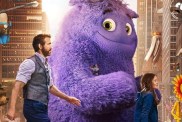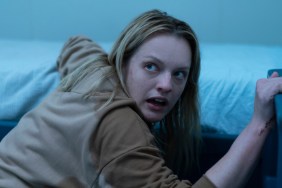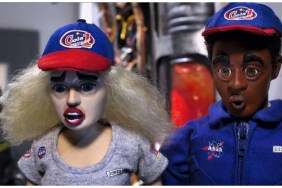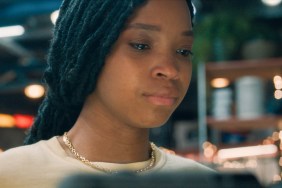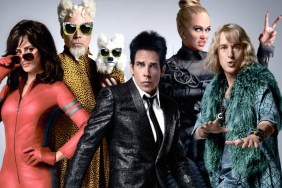A simple story about two road workers trying to make repairs after a devastating fire might not seem like the most logical next step in the career of a director who spent most of the last five years directing irreverent comedies like Pineapple Express and “Eastbound & Down,” but that’s where director David Gordon Green decided to go with his latest Prince Avalanche, another tonal departure in what’s turning into an incredibly diverse career.
It stars Paul Rudd and Emile Hirsch as the two unlikely partners who spend their days fixing up roads, and though much of the film involves the two guys talking, it’s the scenes where they’re not talking that makes it such an introspective film. Not that it would be too surprising for anyone who has followed Gordon Green since his early movies George Washington and All the Real Girls or paid heed to his production work with filmmakers like Craig Zobel and Jeff Nichols in the interim years, but it ends up being one of those quirky likable movies that sneaks up on you rather than hitting you over the head with its message.
Having always enjoyed our conversations with Green over the past few years, ComingSoon.net got on the phone with the filmmaker for an extended interview about the making of Prince Avalanche as well as some general questions about his career decisions and his upcoming movie Joe, starring no less than Nicolas Cage.
ComingSoon.net: I first watched “Prince Avalanche” at South by Southwest, which was a great place to see it, but I think it’s a movie I appreciated more on a second viewing.
David Gordon Green: Yeah, you know what’s weird is that while I was sitting in the editing room day after day, I started picking up on many little nuances that I didn’t even notice that started making me laugh bigger than I was laughing on the day of production. That’s usually rare because there’s a certain kind of charisma and energy when you’re filming that typically, that kinda outshines the moment when you’re sitting in a dark room with some dude. (laughs) The more I got to know this movie and the more these characters started to become familiar to me, it was strange how just little eye rolls would make me laugh or a little glance to the dramatic. The subtlety kinda started to become probably what I’m most proud about the movie I think.
CS: The movie’s mostly just two guys talking (or not talking) which has been done before, but there’s a lot of other things I found to love about it, like the music and how Tim Orr shot the movie, which was really stunning.
Gordon Green: I actually think that the music and the way the camera captures the landscape become the other characters, so I look at it as an ensemble film. You know, there’s obviously the two characters and then a couple of sidekicks that pop in and out, but I think more than most films, the music really played a significant role, and more than most films, the strange melancholy backdrop and the beauty of the green and the rebirth of the forest floor started to say a lot more than necessarily just the banter between two characters would.
CS: But Tim Orr made it all look great and I definitely want to talk more about him. But let’s get back into the basics of it. Obviously, there was this Icelandic film that inspired you in some way to adapt, but it’s also inspired by the fires, so how did you merge those two things together? I haven’t seen the original movie–I’m not sure how many people have–but did also involve road workers after a fire or was it different?
Gordon Green: It was a different landscape. It was about two road workers painting stripes on the road and the kind of barren, vast, nothingness of Iceland. It’s a beautiful, beautiful movie, very few edits in it, just left in some mastershots and a very lyrical, meditative movie with a strange sense of humor. So, I really tried to pay respect to all of those qualities, but I wanted to relocate it to I think a little bit more of a dramatic backdrop and then make it something that felt personal to me. I expanded some of the emotional qualities, expanded some of the feelings of isolation, and then, I brought in this character, Joyce, the woman that Paul meets going though the ashes of her home. I think a lot of that was just open to the opportunities during production. Like, Joyce wasn’t in the script. It was just someone we met when we were scouting and felt really appropriate. When you have a lean, raw production like this, you can really take advantage of things like that, little finds, little treasures. So many of the elements that I find most profound and most rewarding about the experience of making this movie were those not preconceived, not plagiarized from the other film, but those special things that happen when you get a group of really smart, cool, hungry filmmakers in an environment and give them a microscope and say, “Let’s play with it.”

CS: How did you end up with Paul and Emile? Was it very obvious who you wanted to do this as you were writing? I think Paul is a little more obvious for a role like this than Emile, but they’re both great and obviously they work really well together.
Gordon Green: Yeah, well, they’re both actors I’ve known for a while. I met Paul in, I don’t know, maybe 2000. I remember I was at the Rotterdam Film Festival and he was there with a film and he had a huge beard because he was doing “A Long Day’s Journey Into Night” on the stage in London. I met him and I go, “Is this the guy from Clueless’?” I met him in a very curious state. We ended up hanging out in Amsterdam for a few days and becoming friends. Since then, it’s kind of crazy because our careers have gone in very similar paths in a strange way, so we’ve run into each other a lot and spent a good bit of time together talking about making something like this. You know, it’s easy to sit around at a bar with a bar room napkin and scribble down an idea of a potential collaboration and a concept for making a movie, and everybody does that. But, this was one that, you know, I kept kind of dusting off the concept of working with Paul in this way, and when this project kind of came together as dictated by this environment and the kind of timeline that’s sort of filming before the forest totally was receded and re-grew, Paul was the first call I made. I showed him the original film and said, “If I get the rights to this, would this be something you’d be interested in doing?” He jumped on board immediately.
Then, I was trying to think of who would be not an obvious foil for Paul, but someone that would bring humor, but also bring kind of a sensitivity, too. I was really, really careful to try to not have the perception of the film be an outright comedy because it’s not. It’s more dramatic in my own interpretation of the film so I wanted to make sure it wasn’t a comedian. Most of the social circles I have are pretty funny guys, and particularly when we’re talking in terms of recognizable, name value actors, but I’d known Emile for a while. We developed this project “Goat” together that fell apart a few years ago. We had had that introduction and that instinct and interest in working together as well. When I started thinking about who would be an unlikely partner on the road with Paul, Emile jumped out as a great idea, so I got the two of those guys together for a dinner and it was immediately the strangeness of the conversation at that dinner just made me laugh and made me smile. The curiosity of where we could take that in a movie became very exciting to me.
CS: Obviously, there’s stuff that’s very scripted and you have very specific characters and situations that arise, but it seems like there’s a lot of room for improvising especially when we’re watching them do their roadwork and not really talking. I don’t know if you knew much about that aspect of the job and had to train them but was there a lot of improvisation and just shooting things in the woods with the two guys?
Gordon Green: It was kind of an interesting blend of both because I always, regardless of the movie or the genre, I always open it up to improvisation, and I don’t really find scripts to be so essential. A lot of filmmakers use them as gospel, I use them as blueprints. But, this movie, you know, there would be like a six-minute monologue that Emile would give where you’d have a conversation about his weekend and he’s sitting there by the tree, and that’s actually verbatim what was in the script. So, it was really amazing working with actors that could wrap his head around the dialogue you had written and kind of the absurdity of the scenario that he plays very honestly and very dramatically and that makes me laugh. At other times, we would say, okay, we’ve got a day to film Paul wandering around by himself in the woods, where should we go? So, we literally just had a little trailer in the back of the Jeep for props, and we would just drive around filming him fishing. That’s when we found Joyce. That’s when we came up with the pantomime scene in the house. It was just trying to kind of explore our instincts, and it wasn’t necessarily as much improvisation and conversation as it was camera work, as trying to find scenarios and come up with a strange little element of Paul working on his language tapes. You know, we filmed a ton of things, some of which are in there. He cooks a squirrel up and he cuts down a bunch of weeds and pops a few pills and takes a nap in a hammock and we find a turtle walking through the woods. It just seems like a strange environment for a turtle to be walking through the ash, so I was wondering what the turtle would think. Then, we’d just move the camera to take a little journey with him.
CS: The squirrel in the pan really freaked me out. That looked too real.
Gordon Green: Yeah, it was real.
CS: I do want to talk about working with your DP Tim Orr, because obviously you’ve worked with him for so long. There’s a lot of stuff you did in this movie in terms of the nature shots that was simply amazing. Did you just have him shoots lots of stuff or did you have specific visuals in the script you knew you wanted? Do you just let Tim wander around the forest with a camera and shoot stuff that you go through later?
Gordon Green: Yeah, Tim and I, we just finished our ninth film together and we’ve done commercials and TV shows, so it really is that shorthand where we started. Our first collaboration was in film school on a documentary about the artificial insemination of cattle. So, and right there it tells you a real specific sense of the tone of grotesque and absurd and scientific that really fascinates us. We bonded about music on that project. I remember just like, finding a guy that had a very similar sense of taste in music that I had and I think that says a lot, like, in terms of tone and rhythm and atmosphere. What he plays by himself in his car is what I play by myself in my car, and he’s a lot better dancer than I am, but I think it’s a good collaboration. In this particular project, we didn’t have a lighting package, so it set a few rules for us. We weren’t going to be able to shoot at night. There’s some early scenes that are at 5:30, six in the morning, right when the sun was coming up, and we would try to take advantage of the time of day. We don’t have traditional coverage in this movie because there was no lights to compose for a reverse shot, so typically every shot is shot into the sun. There’s a sequence when they first meet the truck driver, he drives up and they have a conversation. We shot everything in one direction when the sun was coming up, and then we shot other stuff during the middle of the day, and then we shot everything in the opposite direction that evening when the sun was going down. I tried to take advantage of the sweetness of natural light in a way that can be sometimes inefficient and inconvenient, but when you don’t have lights and you want everything to look good, you’ve gotta be strategic, and Tim’s the guy that kind of knows how to put that puzzle together.
In Part 2 of our interview, we speak to Green about his upcoming movie Joe starring Nicolas Cage as well as his diverse career decisions. You can read what he had to say about all of that on PAGE 2.
(Photo Credit: WENN.com)


